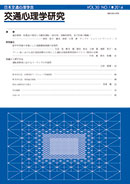The purpose of this study was to categorize drivers into several groups based on their characteristics when using an information presentation system to reduce velocity. Reducing the velocity of a car is very effective at preventing traffic accidents, especially those between vehicles and pedestrians. This information presentation system is used by the driver to stay below the speed limit and can be developed at a low cost. In this study, the driving characteristics of seventeen drivers were investigated through an experiment with actual vehicles and a questionnaire. In addition, the Intelligent Speed Adaptation (ISA) system was developed to present information during the experiments. The test course for the experiment was set up on public roads in the Zone-30 area, which has a speed limit of 30 km/h. Based on the results, factor analysis was conducted to clarify the individual differences between the seventeen drivers regarding the effect of the ISA system. The analysis confirmed that there were many individual differences. Therefore, cluster analysis was performed to categorize the driver characteristics into groups. Based on the results, four driver groups were determined. The ISA system can be improved by optimizing the human-machine interface of the device to each group. If the ISA system is to be made commercially available, it should better implement a function that can categorize a driver into a driver group automatically without cluster analysis. Therefore, the characteristics of each driver group were clarified through the use of state variables regarding vehicle maneuvers such as the velocity or acceleration. This study focused on the frequency distribution of the velocity and the jerk regarding acceleration and deceleration. The results suggest that the frequency distribution of the velocity can be used to categorize the driver groups, and the jerk (i.e., fluctuation in acceleration and deceleration) showed some characteristic tendencies for each group.
抄録全体を表示
